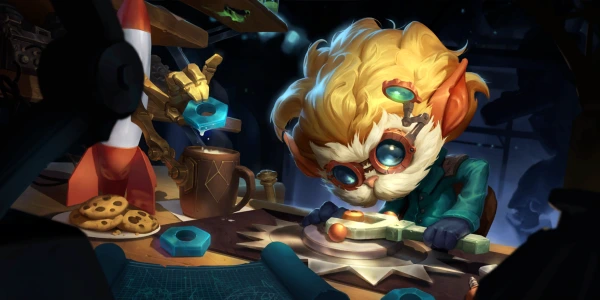It’s another day on the ladder and you’re playing an innocent game of LoR. You get matched against TF/GP and don’t think much about it - it’s yet another aggro deck you’re so used to beating. But then it happens, they cast Make it Rain and … of course it hit the perfect targets it needed to. But wait a second, how likely was that exactly?
and … of course it hit the perfect targets it needed to. But wait a second, how likely was that exactly?
In Legends of Runeterra, there are thankfully not many mechanics that are RNG dependent. But as we are playing a collectible card game, situations are bound to happen where we clench our buttcheeks and pray to the almighty RNGesus. Today, we are taking a look at some of those and how you can take advantage of them.
The randomness of Make It Rain
Imagine the situation from the introduction. Let’s say there are four units on the board, two of which have one HP. How likely is it that Make it Rain hits those two and your nexus?
hits those two and your nexus?
Some people might say the chance is 3/5, as there are five potential targets on the board - your four units and your nexus. But this answer is wrong. As it turns out, it is a more complex question than you might think.
Let’s start a bit simpler. What if I told you there were only two 1 HP units on the board? Then the answer would obviously be 100%.
Ok, that was too easy. What if there is an additional unit on the board then, so three units in total?
To answer this question, think about what target does not get hit by one of the bullets. As there are four targets on the board (including your nexus) and Make it Rain will hit exactly three of them, there will be one unit remaining untouched. Since the targets of Make it Rain
will hit exactly three of them, there will be one unit remaining untouched. Since the targets of Make it Rain are chosen randomly, there are four equally likely cases that can occur, each with a different target left undamaged. Conclusively, the chance of one of them happening has to be 1/4 or 25%.
are chosen randomly, there are four equally likely cases that can occur, each with a different target left undamaged. Conclusively, the chance of one of them happening has to be 1/4 or 25%.
So, this was already a little bit tricky, don’t you think? But wait a minute, it gets even harder. Because if we add another target, we arrive at the initial problem.
“But sensei, can we not just count the targets that don’t get hit again?”
Unfortunately, it’s not that easy. I told you this would be hard, stupid. Don’t worry though, I know just the right person to help us out.
Meet Mr. Binomial Coefficient
The binomial coefficient (n choose k), or (n,k) in short, states the number of possibilities to select k elements out of n. For example, if you had to choose three out of five targets, (5,3) would give you the number of possibilities to do so. See where we are going?
Now consider our question again. If there are four units on the board, how likely is Make it Rain to hit the two 1 HP ones and the nexus? Or differently read, if there are five targets for the three bullets of Make it Rain
to hit the two 1 HP ones and the nexus? Or differently read, if there are five targets for the three bullets of Make it Rain to hit, how likely is the worst-case scenario going to occur?
to hit, how likely is the worst-case scenario going to occur?
To get the probability of our event we calculate "number of possibilities for the desired event" / "total number of possibilities".
Since there is only one possibility for the worst-case scenario, we calculate 1/(5,3) = 10%. This means that in 10% of the cases both of our 1 HP units and our nexus are going to get hit.
The randomness of Make It Rain Part II
Previously, we only considered one specific outcome of Make it Rain , as in for the above formula the numerator was always one. But what happens if we only care about one certain target being hit or not?
, as in for the above formula the numerator was always one. But what happens if we only care about one certain target being hit or not?
Imagine the following situation: We play a Sejuani /Gangplank
/Gangplank Plunder deck and our Sej is about to flip. Next turn though, our opponent will be developing more units and kill us if we can’t level Sejuani
Plunder deck and our Sej is about to flip. Next turn though, our opponent will be developing more units and kill us if we can’t level Sejuani in time and freeze the enemy board. But for that to happen, we need to hit the enemy nexus with Make it Rain
in time and freeze the enemy board. But for that to happen, we need to hit the enemy nexus with Make it Rain this turn. What are our odds?
this turn. What are our odds?
If we can determine the number of possibilities that one of the bullets hit face, we can divide that number by the amount of all possibilities (including not hitting face) and get the probability of our event by the previous formula.
As mentioned before, this time we only care about one of the bullets hitting face and the other two don’t matter. But...how do we calculate that?
Remember Mr. BC? He gives us the number of possibilities to select a certain number of targets out of all. In this case, we can do the following:
If one has to hit the enemy nexus, there are two remaining bullets that have to hit enemy units. Let’s count these possibilities. There are three units on the board, so the number of possibilities to hit two out of three is (3,2), or three. The amount of all possible outcomes of Make it Rain is (4,3), or four.
is (4,3), or four.
Thus, the likelihood for our Make it Rain to hit face and our nexus to not to get wrecked by Ashe
to hit face and our nexus to not to get wrecked by Ashe is 3/4 = 75%. That’s not so bad!
is 3/4 = 75%. That’s not so bad!
Imagine your opponent seeing Make it Rain go face and being like “How unfair, what were the odds for that to happen???11” Then, you can simply repeat in your head “75%” and Back Away Slowly.
go face and being like “How unfair, what were the odds for that to happen???11” Then, you can simply repeat in your head “75%” and Back Away Slowly.
Homework
Did you really think you could just read this article without getting your own mind dirty? Analyze the following screenshot and tell me how likely it is for the Fleetfeather Tracker to get hit! (The screenshot was taken from last week’s EU Seasonal Tournament)
to get hit! (The screenshot was taken from last week’s EU Seasonal Tournament)
Conclusion
Determining how likely certain possibilities in LoR are can be unintuitive at first. I hope this article could give you some insight into how to calculate these probabilities. When you know the likelihood of a certain event, like three exact targets getting hit by Make it Rain , you can decide what’s at risk and if it’s worth playing around - or if you can afford to.
, you can decide what’s at risk and if it’s worth playing around - or if you can afford to.
Knowing the probabilities of certain situations occurring could and should influence your decision-making.
For example, in our first situation, if it was a do-or-die situation for our opponent to hit these exact targets, it would probably be best for us to not play around that 10% chance and instead focus on how to close out the game.
On the other hand, in our second case, it was well above 50% likely that our desired target gets hit, and consequently, our opponent should play around that possibility.
What’s left to say is a big thank you for reading this article!! If you find a mechanic in the game that you think is influenced by RNG, feel free to leave a comment and tell me about it, I might cover it in another episode!


